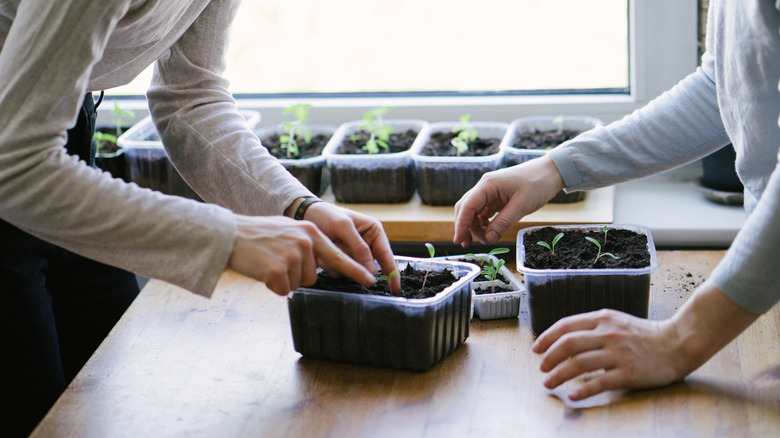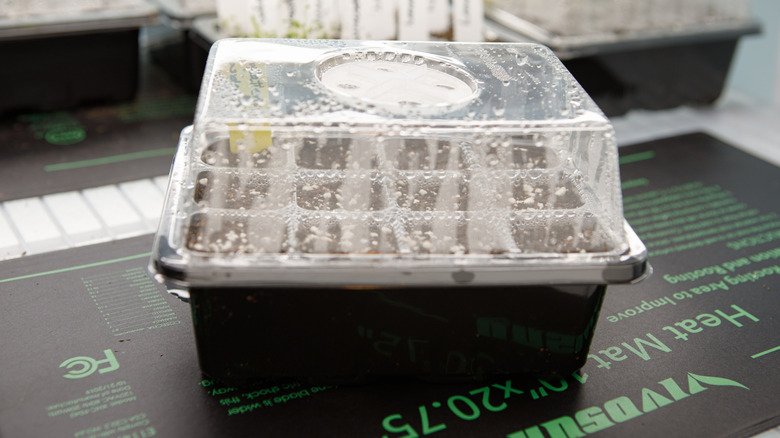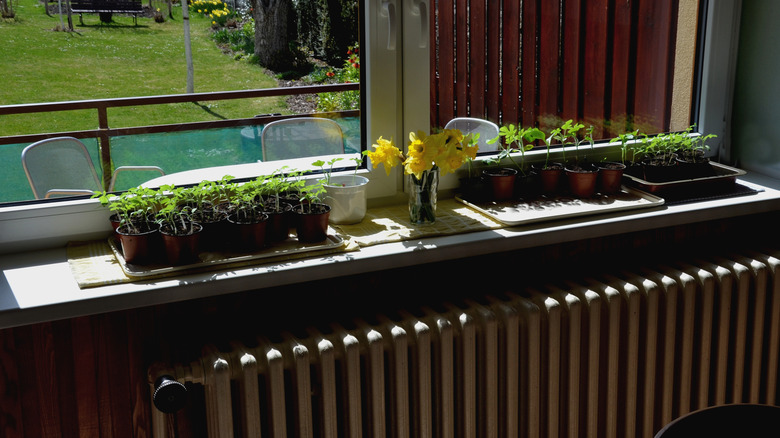Is A Heating Mat Always Necessary For Starting Seeds Indoors?
When starting seeds, there are many factors to keep in mind. Of course, you should understand what seeds you should start indoors and why it matters. Once you have a few seeds to grow, you can start worrying about germination. This occurs when water, oxygen, light, and temperature conditions are best, and will depend on which seeds you're trying to sprout. A temperature range of between 65 and 75 degrees Fahrenheit is good for most, but seed packets may have different recommendations. While this might be achievable in some homes, dark or cool locations, like a basement, may not be warm enough. This will result in fewer seeds germinating and for the process to take longer, so finding a heating solution is helpful. Luckily, there are heating mats available that are designed to gently warm seed trays by sitting underneath them and producing bottom heat. Some come with thermostats, while others just turn on and off to regulate the temperature of the soil.
As great as heating mats sound, they can seem a bit pricey, especially if you're starting seeds for the first time and you're unsure if you will repeat the process. If you're in this position, or if you're just looking to optimize your seeds' germination rate, you may be wondering if heating mats are essential. The answer to this depends on your indoor environment and if you have alternative heating methods available. Achieving the right temperature is important, but heating mats are not always essential.
When and how to use a heating mat for seedlings
To decide if you should use a heating mat for your seedlings, there are two things to check. First, verify the ideal temperature for your seedlings. Corn, cucumber, okra, squash, and watermelon need high optimum soil temperatures at around 80 degrees Fahrenheit, while greens, like spinach, can sprout in soil that's around 40 degrees Fahrenheit. For flowers, ideal temperatures range from 55 to 75 degrees Fahrenheit, depending on the species, and this can vary from day to night. Once you understand the temperature your soil should be, you can test it and see if adjustments need to be made. Soil temperature differs from air temperature, so you will need to take a specific measurement using a thermometer. To do this, just grab a soil or meat thermometer, insert it 1 or 2 inches deep in the soil in an inner cell, and record the temperature. If the this is outside of the recommended germination range, you will need a heat mat or other heating solution to warm your soil.
If you do require a heat source and want to use a heating mat, start by choosing one that is the correct size. The mat should be about the same size as your seed tray so that the heat reaches all parts but there's not too much overlap. Follow the instructions carefully for setup. Heating mats are usually designed to be safe to leave on 24 hours per day until your seedlings have sprouted.
What you can use instead of heating mats
If your soil temperature is too low but you don't want to purchase a heating mat, there are a few DIY methods for raising and maintaining soil temperature. The simplest solution is to move the seedlings to a warm, sunlit window. The heat from the sun should provide some additional warmth, but once the seedlings have sprouted, be sure to avoid promoting leggy seedlings by turning the tray regularly. Another easy solution is to cover your seedlings to incubate them and help the soil better retain heat. You can do this with plastic wrap or lids, but you may also find that aluminum foil is the secret weapon you need when starting seeds.
Placing seedlings around other heat sources in your home, such as near a radiator, on top of a refrigerator, under a heat lamp, or anywhere else that gets gentle warmth, could also be an option. Just be especially careful to avoid creating a fire hazard because putting flammable items near a radiator can be dangerous. No matter which method you use, keep an eye on the seed tray and continue to measure the soil temperature to ensure you're providing the ideal environment for germination.
Overall, if your soil temperature meets the recommendations for the plant you are growing, a heating mat is not necessary. On the other hand, if the soil temperature is too low, a heat mat can be beneficial, but there are alternative solutions you may already have at home that can work as well.


